-

新人教版高中英语选修2Unit 5 Reading and thinking教学设计
The theme of this activity is to learn the first aid knowledge of burns. Burns is common in life, but there are some misunderstandings in manual treatment. This activity provides students with correct first aid methods, so as not to take them for granted in an emergency. This section guides students to analyze the causes of scald and help students avoid such things. From the perspective of text structure and collaborative features, the text is expository. Expository, with explanation as the main way of expression, transmits knowledge and information to readers by analyzing concepts and elaborating examples. This text arranges the information in logical order, clearly presents three parts of the content through the subtitle, accurately describes the causes, types, characteristics and first aid measures of burns, and some paragraphs use topic sentences to summarize the main idea, and the level is very clear.1. Guide students to understand the causes, types, characteristics and first aid methods of burns, through reading2. Enhance students’ ability to deal withburnss and their awareness of burns prevention3. Enable students to improve the ability to judge the types of texts accurately and to master the characteristics and writing techniques of expository texts.Guide students to understand the causes, types, characteristics and first aid methods of burns, through readingStep1: Lead in by discussing the related topic:1. What first-aid techniques do you know of ?CPR; mouth to mouth artificial respiration; the Heimlich Manoeuvre

新人教版高中英语选修2Unit 5 Using langauge-Listening教学设计
The theme of this section is to learn how to make emergency calls. Students should learn how to make emergency calls not only in China, but also in foreign countries in English, so that they can be prepared for future situations outside the home.The emergency telephone number is a vital hotline, which should be the most clear, rapid and effective communication with the acute operator.This section helps students to understand the emergency calls in some countries and the precautions for making emergency calls. Through the study of this section, students can accumulate common expressions and sentence patterns in this context. 1.Help students accumulate emergency telephone numbers in different countries and learn more about first aid2.Guide the students to understand the contents and instructions of the telephone, grasp the characteristics of the emergency telephone and the requirements of the emergency telephone.3.Guide students to understand the first aid instructions of the operators.4.Enable Ss to make simulated emergency calls with their partners in the language they have learned1. Instruct students to grasp the key information and important details of the dialogue.2. Instruct students to conduct a similar talk on the relevant topic.Step1:Look and discuss:Match the pictures below to the medical emergencies, and then discuss the questions in groups.

新人教版高中英语选修2Unit 4 Reading and thinking教学设计
【词汇精讲】highlight n.最好或最精彩的部分 vt.突出;强调;使醒目One of the highlights of the trip was seeing the Taj Mahal.这次旅行的亮点之一是参观泰姬陵。Your resume should highlight your skills and achievements.你的简历应该突出你的技能和成就。The report highlights the major problems facing society today.报告强调了当今社会所面临的主要问题。I’ve highlighted the important passages in yellow.我用黄色标出了重要段落。7.Edmonton is freezing cold in winter,with daily temperatures averaging -10 ℃.埃德蒙顿冬季寒冷,日平均气温为-10°C。【词汇精讲】freezing adj.极冷的;冰冻的Leave a basin of water outside in freezing weather.在冰冻的天气里,放一盆水在室外。It’s freezing cold outside so wear a warm coat.外面超冷的,所以穿一个暖和一点的外套吧。8.It was not until 9:30 a.m.that they finally reached the capital of Ontario,Toronto.直到上午9时30分,他们才终于到达多伦多的首府安大略省。【句式剖析】本句是一个强调句,强调的是句子的时间状语until 9:30。含有not...until...的句子的强调句为It is not until...that...,that后面的句子要用肯定形式。It was not until then that I suddenly realized nobody was happier than I was.直到那时我才突然意识到没有人比我更幸福了。

新人教版高中英语选修2Unit 3 Learning about Language教学设计
1. We'll need ten months at least to have the restaurant decorated.2.Some traditional Chinese dishes from before the Ming Dynasty are still popular today.3.My grandpa's breakfast mainly includes whole grain biscuits and a glass of milk.4.People in this area would eat nearly a kilo of cheese per week.5. We enjoyed a special dinner in a fancy restaurant where the waiters all wore attractive suits.6. He prefers this brand of coffee which, as he said, has an unusually good flavor.Key:1. at a minimum 2. prior to3. consist of4. consume5. elegant6. exceptionalStep 5:Familiarize yourself with some food idioms by matching the meaning on the right with the colored words on the left.1.Public concern for the health of farm animals has mushroomed in the UK2.Anderson may be young but he's certainly rolling to doing dough!3.George is a popular lecturer. He often peppers his speech with jokes.4.As the person to bring home the bacon, he needs to find a stable job.5 He is often regarded as a ham actor for his over emphasized facial expressions. The media reported that these companies had treated pollution as a hot potato. 6.The media reported that these companies had treated pollution as a hot potato.7.Don't worry about the test tomorrow. It's going to be a piece of cake!8. It's best to fold the swimming ring when it is as flat as a pancake.A. completely flatB. something that is very easy to do C.an issue that is hard to deal withD.to include large numbers of somethingE.to earn on e's living to support a familyF. wealthyG.to rapidly increase in numberH. an actor who performs badly, especially by over emphasizing emotions

新人教版高中英语选修2Unit 2 Reading for writing教学设计
The theme of this section is to express people's views on studying abroad. With the continuous development of Chinese economic construction, especially the general improvement of people's living standards, the number of Chinese students studying abroad at their own expense is on the rise. Many students and parents turn their attention to the world and regard studying abroad as an effective way to improve their quality, broaden their horizons and master the world's advanced scientific knowledge, which is very important for the fever of going abroad. Studying abroad is also an important decision made by a family for their children. Therefore, it is of great social significance to discuss this issue. The theme of this section is the column discussion in the newspaper: the advantages and disadvantages of studying abroad. The discourse is about two parents' contribution letters on this issue. They respectively express their own positions. One thinks that the disadvantages outweigh the advantages, and the other thinks that the advantages outweigh the disadvantages. The two parents' arguments are well founded and logical. It is worth noting that the two authors do not express their views on studying abroad from an individual point of view, but from a national or even global point of view. These two articles have the characteristics of both letters and argumentative essays1.Guide the students to read these two articles, and understand the author's point of view and argument ideas2.Help the students to summarize the structure and writing methods of argumentative writing, and guides students to correctly understand the advantages and disadvantages of studying abroad3.Cultivate students' ability to analyze problems objectively, comprehensively and deeply

新人教版高中英语选修2Unit 4 Using langauge-Listening教学设计
The theme of the listening section is " talking about scenery and culture along a journey."The part is designed to further lead the students to understand Canadian natural geography and social environment, and integrated into the cultural contrast by mentioning the long train journey from Beijing to Moscow routes. On this basis, the part activates students related travel experience, lets the student serial dialogue, guides the student to explore further the pleasure and meaning of the long journey, and Chinese and foreign cultural comparison.The part also provides a framework for the continuation of the dialogue, which is designed to provide a framework for students to successfully complete their oral expressions, and to incorporate an important trading strategy to end the dialogue naturally.1. Help students to understand and master some common English idioms in the context, and experience the expression effect of English idioms.2. Guide the students to understand the identity of different people in the listening context, and finish the dialogue according to their own experience.3. Instruct the students to use appropriate language to express surprise and curiosity about space and place in the dialogue, and master the oral strategy of ending the dialogue naturally.1. Instruct students to grasp the key information and important details of the dialogue.2. Instruct students to conduct a similar talk on the relevant topic.

新人教版高中英语选修2Unit 5 Learning about Language教学设计
The purpose of this section of vocabulary exercises is to consolidate the key words in the first part of the reading text, let the students write the words according to the English definition, and focus on the detection of the meaning and spelling of the new words. The teaching design includes use English definition to explain words, which is conducive to improving students' interest in vocabulary learning, cultivating their sense of English language and thinking in English, and making students willing to use this method to better grasp the meaning of words, expand their vocabulary, and improve their ability of vocabulary application. Besides, the design offers more context including sentences and short passage for students to practice words flexibly.1. Guide students to understand and consolidate the meaning and usage of the vocabulary in the context, 2. Guide the students to use the unit topic vocabulary in a richer context3. Let the students sort out and accumulate the accumulated vocabulary, establishes the semantic connection between the vocabulary,4. Enable students to understand and master the vocabulary more effectivelyGuiding the Ss to use unit topic words and the sentence patterns in a richer context.Step1: Read the passage about chemical burns and fill in the blanks with the correct forms of the words in the box.
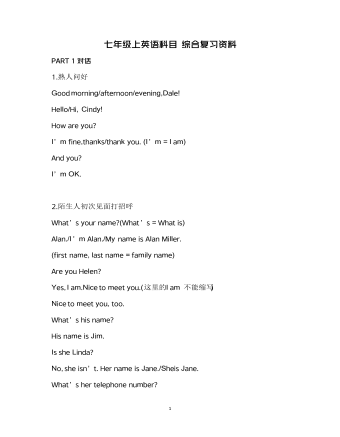
部编版英语七年级上总复习知识点教案
2.陌生人初次见面打招呼What’s your name?(What’s = What is)Alan./I’m Alan./My name is AlanMiller.(first name,last name = family name)Are you Helen?Yes, I am.Niceto meet you.(这里的Iam 不能缩写)Nice to meetyou, too.What’s his name?His name isJim.Is she Linda?
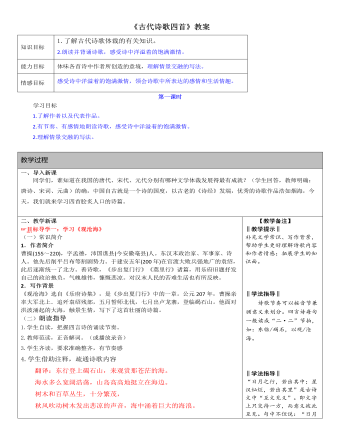
部编版语文七年级上册《古代诗歌四首》教案
(一)常识简介1.作者简介王湾,唐代诗人。生卒年、字号均不详。洛阳(今属河南)人。2.写作背景次北固山下,意思是泊舟停宿于北固山下。作者家住洛阳,旅于江南,在这座山下停泊,被这里开阔秀丽的景色所吸引,写下了这首诗。3.文章体裁《次北固山下》是五言律诗。律诗共八句,一二两句为首联,三四两句为颔联,五六两句为颈联,七八两句为尾联;每句有五个字,叫五言。(二)朗读指导1.学生听读,把握五言诗的诵读节奏。2.教师正音解词,学生自读。(可以播放课文朗读的视频或音频文件。)3.理解大意翻译:旅途在青山外,在碧绿的江水前行舟。潮水涨满,两岸之间水面宽阔,顺风行船恰好把帆儿高悬。夜幕还没有褪尽,旭日已在江上冉冉升起,还在旧年时分,江南已有了春天的气息。寄出去的家信不知何时才能到达,希望北归的大雁捎到洛阳去。
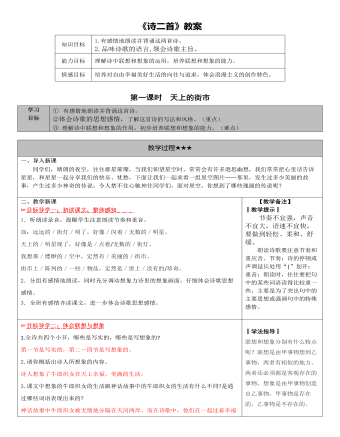
部编版语文七年级上册《诗二首》教案
目标导学三:品味语言,拓展延伸 1.第一节的运用了什么修辞?有何好处? 运用了比喻的修辞。前两句的比喻,本体是“街灯”,喻体是“明星”;后两句比喻的本体是“明星”喻体是“街灯”。这是一种回环往复的比喻,读起来特别的美,而内容上又从地上联想到了天上。这两个比喻构成了从地上写到天上的桥梁或天梯,写得天衣无缝,不露痕迹,非常自然。 2.后面三节,用了四个“定然”,一个“定”,有什么作用? 诗中的“定然”“定”表现的明明是想象的内容,却用断定的语气加以肯定,表明作者坚信,这样的理想世界是存在的,他对美好的未来充满信心,使读者受到感染和鼓舞。 3.“不信,请看那朵流星”中“朵”可不可以换成“颗”?“朵”用来作流星的量词,而不用“颗”,写出了流星的美,就像花儿一样。与牛郎织女的美好生活相映成趣。

部编版语文九年级上册《醉翁亭记》教案
一、导入新课范仲淹因参与改革被贬,于庆历六年写下《岳阳楼记》,寄托自己“先天下之忧而忧,后天下之乐而乐”的政治理想。实际上,这次改革,受到贬谪的除了范仲淹和滕子京之外,还有范仲淹改革的另一位支持者——北宋大文学家、史学家欧阳修。他于庆历五年被贬谪到滁州,也就是今天的安徽省滁州市。也是在此期间,欧阳修在滁州留下了不逊于《岳阳楼记》的千古名篇——《醉翁亭记》。接下来就让我们一起来学习这篇课文吧!【教学提示】结合前文教学,有利于学生把握本文写作背景,进而加深学生对作品含义的理解。二、教学新课目标导学一:认识作者,了解作品背景作者简介:欧阳修(1007—1072),字永叔,自号醉翁,晚年又号“六一居士”。吉州永丰(今属江西)人,因吉州原属庐陵郡,因此他又以“庐陵欧阳修”自居。谥号文忠,世称欧阳文忠公。北宋政治家、文学家、史学家,与韩愈、柳宗元、王安石、苏洵、苏轼、苏辙、曾巩合称“唐宋八大家”。后人又将其与韩愈、柳宗元和苏轼合称“千古文章四大家”。

人教部编版七年级语文上册古代诗歌四首教案
学生在小学阶段已经学过一定数量的古代诗歌,以启发学生的形象思维为主,重在理解诗歌大意,在此基础上进行朗读和背诵,对诗歌的思想感情的体会和艺术手法的学习涉及较少。初中阶段则要求在此基础上兼顾抽象思维的培养,在进一步激发学生对古代诗歌兴趣的前提下,引导学生初步欣赏古代诗歌,培养初步赏读诗歌的能力。本课是初中阶段第一次集中学习古代诗歌,所选的四首诗歌文质兼美。学习这四首古代诗歌,不仅可以提高学生对身边自然之景的感受力,还有利于培养学生健康向上的精神品格和生活情趣。基于学生的实际能力,也考虑到保护学生学习古代诗歌时的热情,本课设计对学生欣赏诗歌没有提出过高的要求,对学习诗歌时常提到的“意象”“意境”也少有提及。设计中继承了小学阶段朗读和背诵的优良习惯,以诵读贯穿教学始终。同时,在教学中还有意识地增加了一些古代诗歌的常识,如体裁、节奏和韵律等,并极力引导学生用“知人论世”的方法对诗歌情感与内涵有相对深层次的理解,以期望学生能在现有的能力层级上,最大限度地浸润于古典作品中,受到潜移默化的熏陶感染。
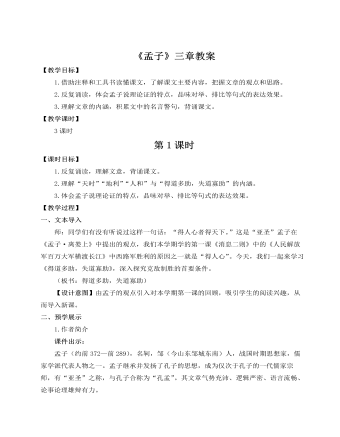
人教部编版语文八年级上册《孟子》三章教案
【设计意图】引导学生梳理文章内容,学习文章层层推理的特色。四、当堂检测《生于忧患,死于安乐》中提出担当大任的人必须经过艰苦的磨炼。请根据查找的相关资料,补充一些例子,并说说你的看法。1.司马迁受宫刑而作《史记》。2.曹雪芹举家食粥而写出了不朽的《红楼梦》。3.贝多芬即使在双耳失聪的情况下,仍然坚持音乐创作。(生交流讨论,举手发言)师小结:美国剧作家帕特里克说:“痛苦使人思索,思索使人明智,智慧使人生命持久。”优越的条件容易消磨人的意志,腐蚀人的健康肌体,使人丧失成功的上进心;而艰苦的环境,坎坷的道路,却能磨炼人的意志,增强人的上进心。学习了本文,希望大家悉心体会,思有所悟,学有所获。【设计意图】增强学生的忧患意识,激励学生要有克服困难的信心和勇气,学会正确对待生活中的困境。
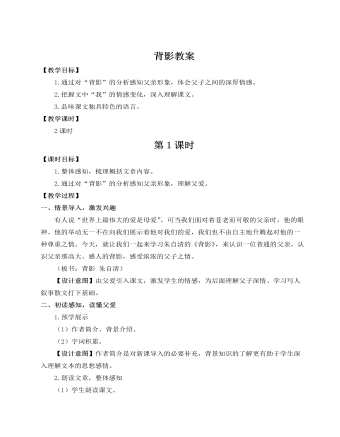
人教部编版语文八年级上册背影教案
一提到朱自清,大家脑海里闪现出的便是《荷塘月色》《背影》《匆匆》等美文。位于昆明司家营的朱自清旧居,这座“一颗印”老宅不仅承载着七十多年前以朱自清为代表的清华文科研究所师生的家国情怀,也记录着朱自清那些不为人知的故事。这些故事,将撕开朱自清身上“散文家”“诗人”“学者”“民主战士”的标签,让大家看到一个不一样的朱自清!“时尚达人”朱自清1942年冬天,昆明天气格外寒冷,如何温暖过冬成了朱自清头疼的大问题。身上的旧皮袍已经缝补了许多次,早已抵挡不住瑟瑟寒风。掏掏口袋,发现生活费都够呛,更不要说缝制新棉袍,于是朱自清做了一个决定。趁着龙头街赶街的日子,朱自清给自己挑了一件赶马人穿的、制作粗糙、价格便宜的毡披风。朱自清一毡多用,出门时,他就将毡披风披在身上御寒,晚上睡觉时,毡披风一脱就当被褥。朱自清上街,里边穿西装,外边穿赶马人的毡披风,给联大师生留下了深刻的印象。这件毡披风由于太过显眼,被誉为“联大三绝”,也成了他教授生活清贫的标志,以至于后来多次出现在回忆朱自清的朋友的笔下。

人教部编版语文八年级上册诗词五首教案
设问2:下片主要写了什么内容?预设 回答天帝。下片紧承上片的天帝询问,作出回答。我报路长嗟日暮,学诗谩有惊人句。(这是词人回告天帝。一个“嗟”字,生动地传达出作者对日暮途远的叹息,感慨空有才华,于世事无补。)九万里风鹏正举。风休住,蓬舟吹取三山去!(回答天帝,希望自己像大鹏一样高飞远走,到海上仙山去。传达出词人对现实的厌弃和对美好境界的追求。)设问3:本词和《赤壁》都表现了作者对自身才华、命运的认识,但又有什么不同?预设 杜牧借对三国史事的遐想,慨叹历史上英雄成名的际遇,曲折表达自己空有抱负,生不逢时、无从施展的无奈;本词是借梦境与天帝对话,表达对自己空有一身文学才华却屡遭战乱,甚至连个人的安定幸福都无法保障的不满。【设计意图】本环节旨在品读《渔家傲》,引导学生通过品读词句,感知词作内容,理解词人情感,并通过鉴赏艺术手法,提高审美能力。
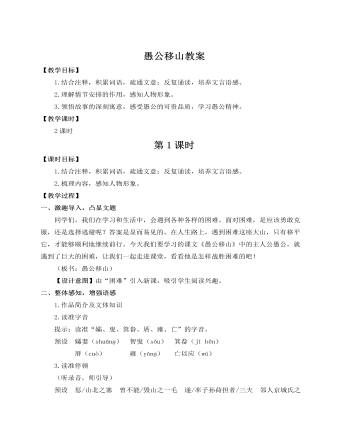
人教部编版语文八年级上册愚公移山教案
阴阳原是指日光的向背,向日为阳,背日为阴。我国古代地名中的“阴”和“阳”实际上是一种方位指示,“日之所照曰阳”,也就是说太阳所能照到的地方就称为阳。 山水阴阳是说古代以山南、水北为阳,以山北、水南为阴。 形成这种局面的原因是山峰高耸,日光能照射到的地方是山的南面;而河流位于地平面以下,所以太阳能照射到的地方其实是河流的北面。 故有“山南水北谓之阳,山北水南谓之阴”的说法。在我国历史上,很多地名及地理表述都与此关系密切,如江阴、衡阳、汉阳等。 《愚公移山》 中说:“指通豫南,达于汉阴。” 其中的“汉阴”是指汉水的南岸。 “泰山之阳,汶水西流;其阴,济水东流”(姚鼐《登泰山记》)、“所谓华山洞(南宋王象之《舆地纪胜》写为‘华阳洞’。 看正文下句,应为‘华阳洞’)者,以其乃华山之阳名之也”
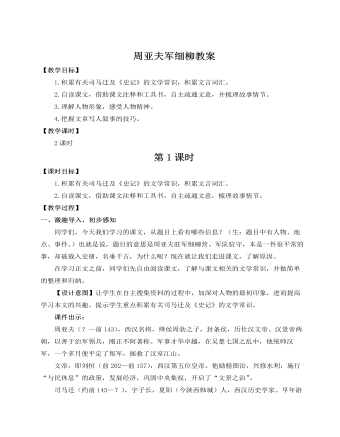
人教部编版语文八年级上册周亚夫军细柳教案
文帝之后六年,匈奴大入边。乃以宗正刘礼为将军,军霸上;祝兹侯徐厉为将军,军棘门;以河内守亚夫为将军,军细柳:以备胡。这一段主要围绕“大入边”之“大”来构建段落。整段文字看似与“大”无关,实则处处围绕“大”字做文章。写汉文帝三封将军“以备胡”,这是从内容上写胡人“入边”之“大”:边关吃紧,战势严峻。为了达到内容与形式的珠联璧合,司马迁在言语上连用三个“以……为……”的排比句式,以排山倒海的“声”势从言语上体现了“大”,以此增强文章的气势,形成一种“山雨欲来风满楼”的危急感。不仅如此,司马迁甚是在意言语细节。在连用三个“以……为……”时,打破言语的惯性,突然在第二个“以……为……”中省略了“以”字,这看似唐突,实则其心可鉴,省略第二个“以”字后,“以宗正刘礼为将军,军霸上;祝兹侯徐厉为将军,军棘门”不仅在视觉上间隔缩短,而且在朗读时彼此节奏加紧,联系更加紧密,军情更显危急,胡人“入边”之形势就显得更“大”了。而且,三个“以……为……”;“……为……”;“以……为……”之间张弛有度,一紧一松,营造了语势上的跌宕起伏,极具音韵之美。
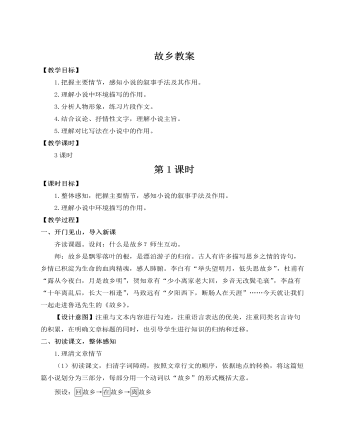
人教部编版语文九年级上册故乡教案
文章第84、86段的抒情、议论,写“我”远离故乡并不感到怎样的留恋,反倒非常气闷、悲哀。本来在“我”心目中,故乡是非常美好的,但是回乡迁居却使之前的印象破灭了。故乡人与人之间、“我”与故乡之间,充满隔膜。“我”对故乡人的生活现状和命运感到痛苦和悲哀。3.“我”的自省揭示主题预设:文章结尾部分,“我”在离乡的航船上再次想起故乡的人和事,痛苦地意识到“我”和闰土、杨二嫂等人已经有了精神上的隔膜。闰土叫“我”“老爷”,杨二嫂认为“我”“放了道台”,孩提时代那种真诚友善的关系,已经完全消失了。“我”对旧中国的人民怀着深切的同情,叹息他们所承受的日复一日的苦难生活,更愤懑于由这种生活所造成的人与人之间的彼此隔膜,期望着打破这种旧生活,迎来“为我们所未经生活过的”“新的生活”。“我”渴望打破封建社会的等级观念,渴望建立超越庸俗的物质关系的新型的人与人之间的关系。【设计意图】“横看成岭侧成峰,远近高低各不同”,对小说主题的理解见仁见智。引导学生理解小说主题,要立足于文本。本文写于1921年1月,不可避免地打上“五四”新文化运动的烙印,理解小说主题,要结合这一时代背景。
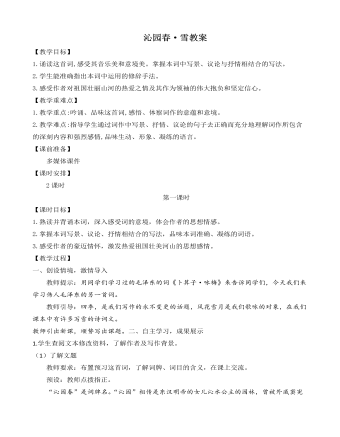
人教部编版语文九年级上册沁园春·雪教案
3. 同学们,我们再从表达方式方面去考虑一下。教师指正:写景、抒情、议论相结合。这是一首雄壮的抒情词作。上阕写景,气势磅礴、气象雄浑,而又寓情于景,句句洋溢着热爱祖国河山的豪情。下阕议论,由评论历史人物转到歌颂当代无产阶级英雄,抒发作者的豪情壮志。全词熔写景、议论和抒情于一炉,使主题鲜明突出,表现出强烈的艺术效果。五、 课堂检测,当堂反馈要求学生当堂做完下列题目,师生再共同订正,看看还有哪些知识没有掌握,教师及时要求学生巩固。六、知识迁移,拓展延伸1. 请同学们下面读一下柳宗元的《江雪》,回答后面的问题。教师:唐代著名文学家柳宗元写过的这首《江雪》,言简意深。请同学们思考分析,这首诗与《沁园春·雪》在感情基调上有什么不同?是什么原因造成的? 教师指正:柳宗元因参加革新运动失败而遭贬,他的政治思想和远大抱负不能实现,内心的苦恼与愤懑反映在诗中,就是那个卓尔不群、孤芳自赏、“独钓寒江雪”的“蓑笠翁”。而毛泽东的词作大气磅礴,格调高亢,充满了热爱祖国河山、以天下为己任的豪情壮志。这种差别,主要是由于作者所处的时代、境遇,特别是胸怀的阔狭造成的。
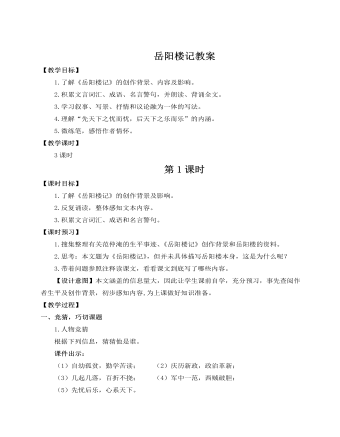
人教部编版语文九年级上册岳阳楼记教案
同是写景,第2段要读出激昂豪迈之情。例如:衔远山,吞长江,浩浩汤汤,横无际涯,朝晖夕阴,气象万千,此则岳阳楼之大观也。第3段要读出悲凉失落之感。例如:若夫淫雨霏霏,连月不开,阴风怒号,浊浪排空,日星隐曜,山岳潜形,商旅不行,樯倾楫摧,薄暮冥冥,虎啸猿啼。第4段要读出欢快愉悦之情。例如:至若春和景明,波澜不惊,上下天光,一碧万顷,沙鸥翔集,锦鳞游泳,岸芷汀兰,郁郁青青。【设计意图】本文生字词较多,一定要先读准字音,认准字形结构。从句式看,骈散结合,读起来朗朗上口,可以感受音韵美。加强诵读训练,可以培养语感,快速成诵,促进感知文本内容。4.寻找读,积累词句(1)找出文中出现的成语,并探究它们在今天的意义。课件出示:气象万千:形容景色和事物多种多样,非常壮观。政通人和:政事顺遂,人民和乐。形容国泰民安。百废具兴:各种被废置的或该办未办的事业都兴办起来。(在现代汉语中,“具”写作“俱”)










